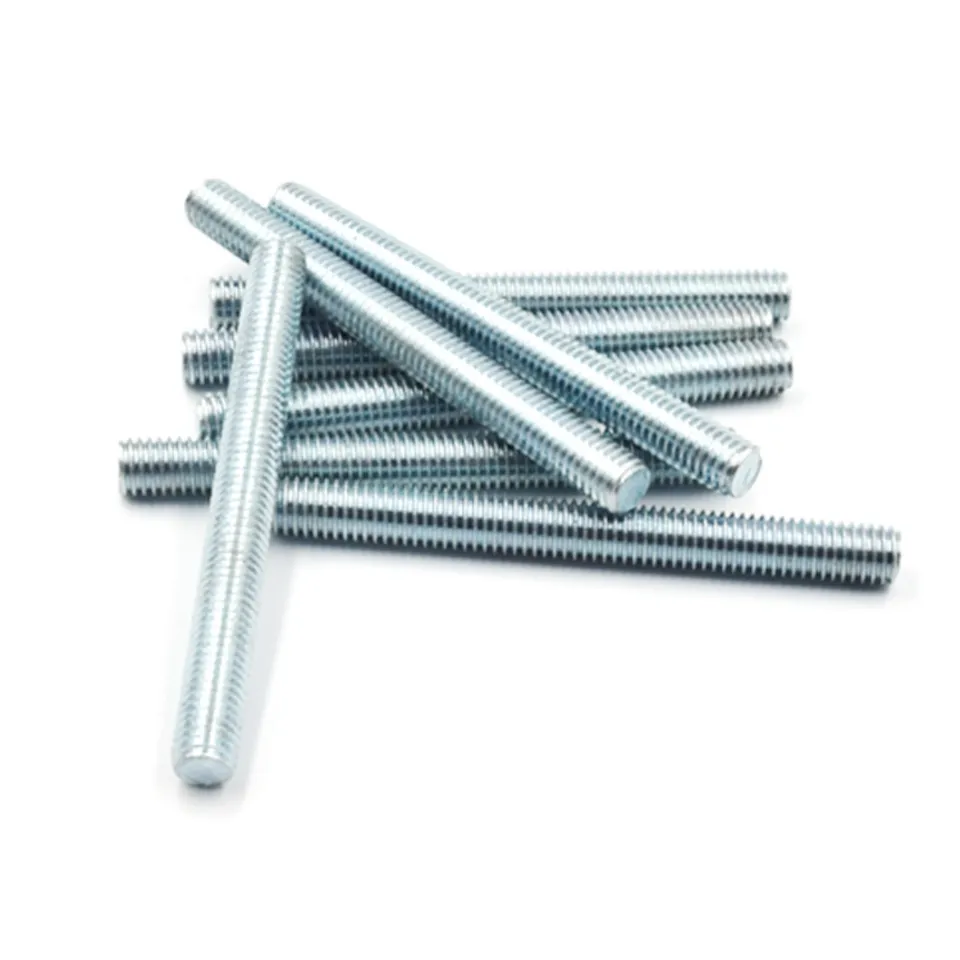DIN976 Fully Threaded Stud Bolts
DIN976 stud bolts is a German Industrial Standard that specifies the dimensions and technical requirements for fully threaded stud bolts. These stud bolts have threads along their entire length and are designed to be used in applications where components need to be fastened together with a threaded connection.
DIN976 fully threaded stud bolts are available in various materials, sizes, and property classes, allowing them to be used in a wide range of industrial applications. They are often used in construction, machinery, and other industries where a strong and reliable threaded connection is necessary. The standard defines the dimensions, thread pitches, and other characteristics to ensure compatibility and proper performance.

Dimension of DIN976 Fully Threaded Stud Bolts:
The dimensions of DIN976 fully thread stud bolts can vary depending on the specific size and thread pitch. DIN 976 is a standard that covers a range of threaded rod sizes, and each size will have its own set of dimensions. The key dimensions typically specified in DIN 976 for threaded rods are as follows:
| Product name | DIN975 threaded rods |
|---|---|
| Diameter | M2 – M100 |
| Length | up to 6000mm |
| Thread | Metric thread |
| Material | Steel/stainless steel/brass/aluminum |
| Manufacturing Process | wire drawing, thread rolling, heat treatment, surface treatment |
| Surface treatment | Black Oxide Coating/Zinc Plating (Electroplating)/Hot-Dip Galvanizing/Mechanical Galvanizing/Dacromet Coating/Painting or Powder Coating |
| Application Industry | Construction/Machinery/Automotive/Infrastructure/Electrical and Electronics/Furniture/Marine and Offshore |
For example, a common DIN976 fully thread stud bolts might have dimensions like M10 x 1.5, where M10 represents a 10mm diameter with a thread pitch of 1.5mm.
It is crucial to select the appropriate size and grade of the threaded rod based on the specific application’s requirements, load-bearing capacity, and environmental conditions. For precise and accurate dimensions, it is best to refer to the official DIN 976 documentation or consult a reliable reference source for the specific threaded rod size you are interested in.
Carbon Steel Chemical Composition for DIN976 Fully Threaded Stud Bolts
| Property class | Material and heat treatment | Chemical composition limits (cast analysis, %) a | Tempering temperature |
||||
|---|---|---|---|---|---|---|---|
| C | P | S | B | °C | |||
| 4.6 | Carbon steel or carbon steel with additives | min | max | max | max | max | min. |
| 4.8 | - | 0.55 | 0.05 | 0.06 | Not specified | - | |
| 5.6 | 0.13 | 0.55 | 0.05 | 0.06 | |||
| 5.8 | - | 0.55 | 0.05 | 0.06 | |||
| 6.8 | 0.15 | 0.55 | 0.05 | 0.06 | |||
| 8.8 | Carbon steel with additives (e.g. Boron or Mn | 0.15 | 0.4 | 0.025 | 0.025 | 0.003 | 425 |
| Carbon steel quenched and tempered | 0.25 | 0.55 | 0.025 | 0.025 | |||
| Carbon steel quenched and tempered | 0.20 | 0.55 | 0.025 | 0.025 | |||
| 10.9 | Carbon steel with additives (e.g. Boron or Mn | 0.20 | 0.55 | 0.025 | 0.025 | 0.003 | 425 |
| Carbon steel quenched and tempered | 0.25 | 0.55 | 0.025 | 0.025 | |||
| Carbon steel quenched and tempered | 0.20 | 0.55 | 0.025 | 0.025 | |||
| 12.9 | Alloy steel quenched and tempered | 0.3 | 0.5 | 0.025 | 0.025 | 0.003 | 425 |
| 12.9 | Carbon steel with additives (e.g. Boron or Mn or Cr or Molybdenum) quenched and tempered | 0.28 | 0.5 | 0.025 | 0.025 | 0.003 | 380 |
Mechanical and physical properties
| Mechanical or physical property | Property class | ||||||||
| 4.6 | 4.8 | 5.6 | 6.8 | 8.8 (d≤16mm) | 8.8(d>16mm) | 10.9 | 12.9 | ||
| Tensile strength, Rm, MPa | nom. | 400 | 400 | 500 | 600 | 800 | 800 | 1000 | 1200 |
| min. | 400 | 420 | 500 | 600 | 800 | 830 | 1040 | 1220 | |
| Lower yield strength, ReL d, MPa | nom. | 240 | - | 300 | - | - | - | - | - |
| min. | 240 | - | 300 | - | - | - | - | - | |
| Stress at 0,2 % nonproportional elongation, R p0,2, MPa | nom. | - | - | - | - | 640 | 640 | 900 | 1080 |
| min. | - | - | - | - | 640 | 660 | 940 | 1100 | |
| Percentage elongation after fracture for machined test pieces, A, % | min. | 22 | - | 20 | - | 12 | 12 | 10 | 8 |
| Percentage reduction of area after fracture for machined test pieces, Z, % | min. | - | 52 | 48 | 44 | ||||
| Vickers hardness, HV F W 98 N | min. | 120 | 130 | 155 | 190 | 250 | 255 | 320 | 385 |
| max. | 220 | 320 | 335 | 380 | 435 | ||||
| Rockwell hardness, HRC | min. | - | - | - | - | 22 | 23 | 32 | 39 |
| max. | - | - | - | - | 32 | 34 | 39 | 44 | |
Surface treatment of DIN976 Fully Threaded Stud Bolts:
| Surface treament | Feature | Benefits |
|---|---|---|
| Black Oxide Coating | Creates a dark or black surface finish through a chemical reaction. | Enhances appearance, provides some corrosion resistance, reduces glare, and can offer moderate wear resistance. |
| Zinc Plating (Electroplating) | Provides a thin layer of zinc coating on the surface. | Offers moderate corrosion resistance, enhances appearance, and can act as a sacrificial barrier against corrosion. |
| Hot-Dip Galvanizing | Immerses the bolts and nuts in molten zinc to create a thicker coating. | Provides strong corrosion protection, suitable for outdoor and harsh environments, forms a durable and rugged coating. |
| Mechanical Galvanizing | Uses mechanical means to apply a zinc coating. | Offers good corrosion protection, especially for high-strength bolts, less risk of hydrogen embrittlement compared to hot-dip galvanizing. |
| Dacromet Coating | A sacrificial coating that includes a mix of zinc and aluminum flakes. | Offers exceptional corrosion resistance, suitable for extreme conditions, provides consistent friction control, and maintains coating integrity even under mechanical stress. |
How do we ensure the quality of DIN976 Fully Threaded Stud Bolt?
| Control Method | Detail |
|---|---|
| Material Inspection: | Verify the material's composition, heat treatment, and quality upon receipt. Conduct metallurgical analysis to ensure the material properties meet the standards. |
| Process Control: | Implement strict process control measures for heat treatment, machining, threading, and any other manufacturing steps. Maintain consistent process parameters to ensure uniform quality. |
| Inspection Points: | Introduce inspection points at various stages of manufacturing to check for defects, dimensions, and quality. Inspect threading, dimensions, surface finish, and other critical parameters. |
| Sampling and Testing: | Regularly sample products for testing, such as tensile testing, hardness testing, and metallurgical analysis, to ensure they meet the required specifications. |
| Thread Inspection: | Thoroughly inspect threading using proper thread gauges to ensure accurate dimensions and fit with mating components. |
| Traceability: | Implement a traceability system to track each fasteners journey from raw material to final product. This aids in accountability and recalls if necessary. |

